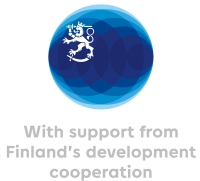Nepal
Nepal is among the poorest countries in the world with a population of 31 million people. Approximately one-quarter of its population is living below the poverty line. In April 2015, Nepal was hit by two major earthquakes, resulting in the loss of 8 800 lives (including children), the injury of more than 17 000 people and the destruction of or damage to over 500 000 houses. Even a year after the earthquake of 600 000 families were without a permanent home. Nepal’s mountainous terrain is slowed the delivery of aid and Nepal is still recovering from the devastation caused by the quake.
Save the Children Finland project areas Sindhupalchowk and Kavrepalchowk were some of the areas worst affected by the earthquake. Save the Children have been working there since 2006. Many child protection issues – such as the increase in child trafficking, separation from families, child labour, sexual abuse and psychological problems amongst children – emerged in earthquake-affected communities. After the earthquake, we focused on three months solely for humanitarian work in disaster areas. We focused reducing children’s and their parents’ psychosocial distress through psychosocial support and counselling targeting parents, caregivers and children creating a sense of safety and wellbeing in the affected communities.
Save the Children aims to reduce child trafficking, the use of child labor and violence against children through social security, child protection and advocacy. In addition, we have promoted better parenting and care-related practices, for example by guiding and training the children’s caregivers. We have set up groups for children, where they are taught, for example, life skills and self-protection. Save the Children also supports child trafficking and exploitation victims. We aim to promote children’s school attendance and reduce the number of malnourished children in Nepal.

In Nepal we train children’s caregivers, for example, of healthy and nutritious food.
Save the Children has improved access to social protection through increased transparency and accountability of an application process. We have shared information and thereby enhanced their awareness of social security programs. In this way people eligible for social protection have become more aware of how to hold the government to account when it comes to accessing social protection and the government feels the pressure to become more responsive to public demands. The aim is also to increase the targeted Nepalese government social security programs for children, to get them more funding and increase in child-orientation of existing programs, which is that they take better account of the needs of children.
With the support of Save the Children local child protection systems are gradually stabilized and district-level child protection systems have been developed in a coordinated manner. These child protection systems were activated effectively after the earthquake in 2015. They were able to determine, for example, alone, unaccompanied and otherwise vulnerable children in Nepal’s quake-hit areas. Because of that, it was possible to provide help for the children who need it most.
Mariam benefitting access to social protection
4-years-old Mariam lives with her mother, father, two siblings and grandmother. Mariam’s mother is disabled, she paralysed after Mariam’s birth so grand mother looks after Mariam quite a lot and Mariam is very attached to her. Her mother gets disability allowance. During earthquake in 2015 their house collapsed completely. The family is very poor and they are Dalit. Mariam attends a school regularly.
mother looks after Mariam quite a lot and Mariam is very attached to her. Her mother gets disability allowance. During earthquake in 2015 their house collapsed completely. The family is very poor and they are Dalit. Mariam attends a school regularly.
Save the Children has helped Mariam and her family in many different ways. We have trained her caregivers how they could keep better care of Mariam and his nourishment. We have also encouraged Mariam’s family to take her to regular growth monitoring at health post to make sure Mariam is growing well. Before as grandmother said that they fed her only once per day and sometimes they left her at home on her own when went to work. Mariam’s grandmother attended parenting education sessions and learned that the Mariam should be fed 4 times per day and with healthy, nutritious foods. In addition, with our support, Mariam was provided access to Nepalese government social protection scheme ”child grant”, which belonged to her. Her family just didn’t know about child grant before. The family uses the money to buy vegetables and more nutritious food, which they couldn’t afford otherwise. Save the Children also provides Mairam meal package for the school as well as school materials. Today, Mariam grows well and is healthy and happy child.
Nepal’s projects is funded by the Finnish Ministry of Foreign Affairs and Finnish individual donors.
PUBLICATIONS
- Child Sensitive Social Protection in Nepal – Project Brief 2020
- A Parenting Programme for the Child Grant: Facilitator Guide – Nepal (2020)
- Research brief: Assessment of a Parenting Pilot Intervention linked to the Child Grant in Nepal (2019)
- A Qualitative Pre- and Post-assessment Study of a Parenting Programme for the Child Grant in Nepal (2019)
- Securing Access to Government Social Protection in Nepal: An approach developed by Save the Children (2019)
- Improving Social Protection’s Response to Child Poverty and Vulnerability in Nepal (2016)
- Assessment of Save the Children’s Child Sensitive Social Protection Approach in South Asia (2015)
- Putting Child Sensitive Social Protection into Practice in Nepal – Approach Paper (2014)

